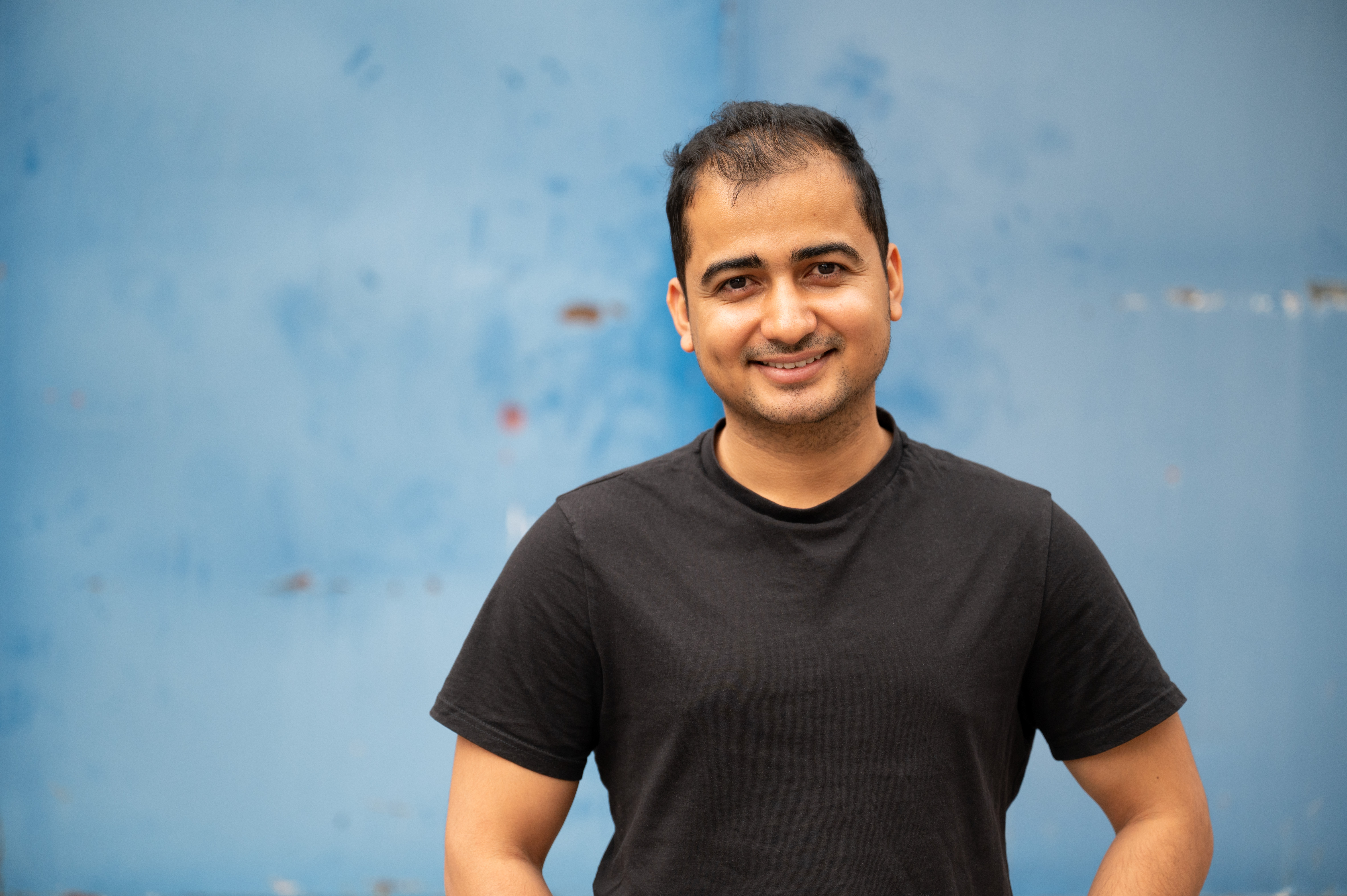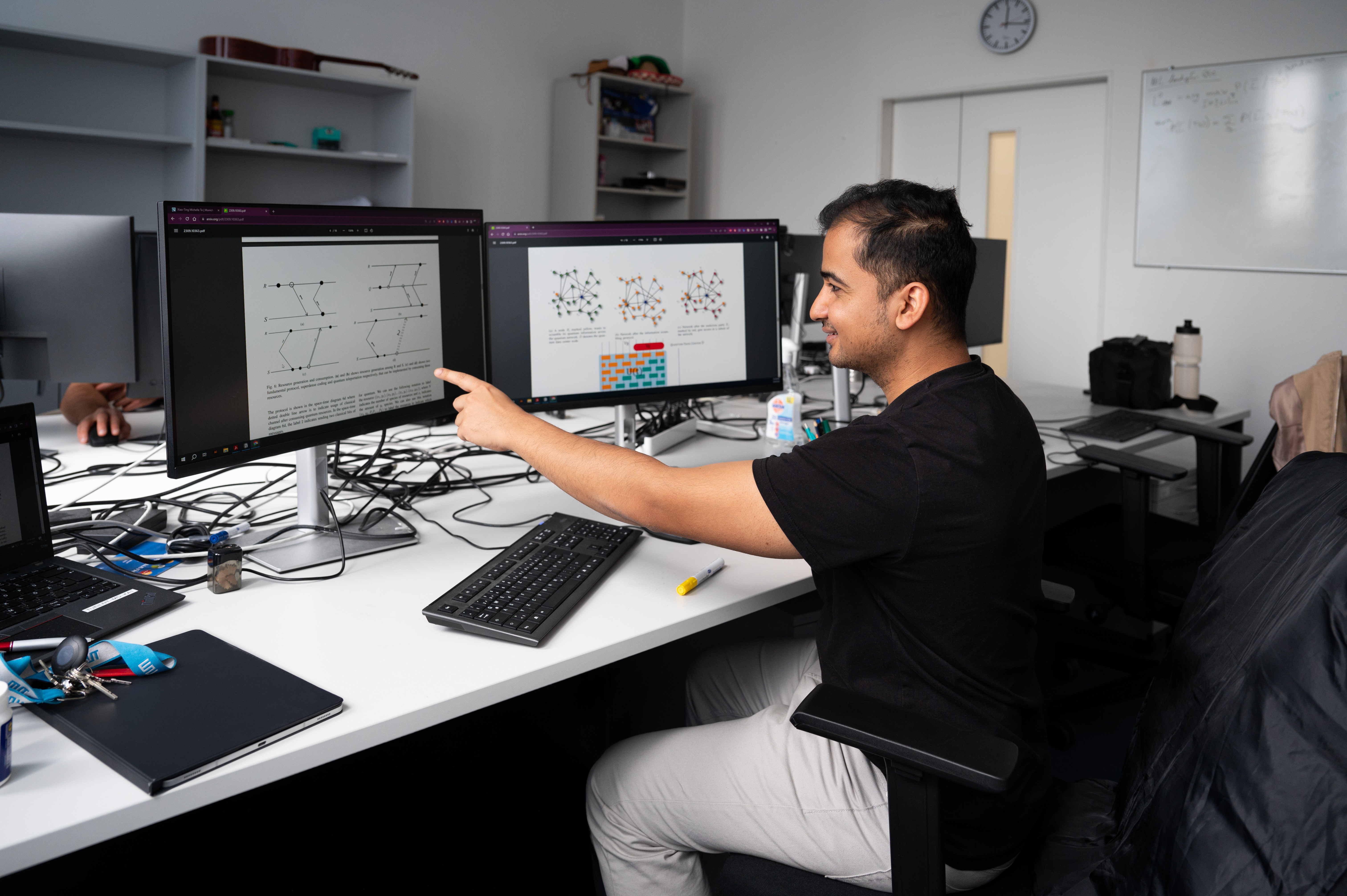"Something exciting is happening here"
Understanding quantum physics with information theory
Kiran Adhikari has no shortage of ideas – whether they are solutions to specific mathematical problems, new approaches to his research on the quantum internet, or ways to help others. He realizes his ideas with great dedication, driven by curiosity and always striving to think outside the box.
By Maria Poxleitner
At first glance, it looks like a strange kind of musical notation: several horizontal black lines with black and white dots on them, like different note values, arrows connecting the dots and lines in between. Sitting in his office on Theresienstraße near downtown Munich, Kiran Adhikari points to the strange graphic: "This is a way of visualizing a quantum internet protocol."
In his doctoral thesis, the theoretical physicist is researching distributed quantum networks, also known as quantum internet. In the same way that classical computers can communicate with each other around the world via the Internet, quantum computers shall also be connected to each other in the future. In abstract terms, one speaks of nodes and channels. The nodes of the network can be individual qubits or entire quantum computers. Quantum information can then be exchanged between the nodes via channels, for example, via fiber-optic cables. However, researching and building up a quantum internet experimentally is extremely elaborate and challenging. So far, only single components or small networks with very short range have been realized in laboratories.
Visualizing the information flow in a quantum network
"As theorists, we have to show that it is worth the effort by exploring new applications that justify building up such large networks," Kiran explains. For example, they are looking for protocols – recipes, so to speak – on how to distribute quantum information as efficiently as possible over a quantum network. The graphical representation of such protocols, which the young doctoral student proposed in a paper this fall, can help. Each of the horizontal lines represents a node and its evolution over time, the dots on the lines represent different events at the nodes, and arrows indicate that information is being sent from one node to another. “We are not interested in what happens in detail, for example, which individual gates occur in the protocol," explains the 27-year-old. That would quickly become too confusing with larger protocols. "We are interested in how information flows. Which event affects which one, and how many resources, such as entangled states, are needed for a protocol. These are two important things that we can visualize with these diagrams.”
Kiran wrote his master's thesis in Aachen with David DiVincenzo, one of the pioneers of quantum computing. However, his thesis was not on quantum computing, but on quantum gravity. Physicists are trying to unify quantum mechanics and relativity into one theory. During his bachelor’s degree in Bremen, he had already worked on quantum computing, the physicist says, but then he realized that quantum information was getting quite popular in quantum gravity. "People are trying to solve problems with information-theoretical approaches. Quantum information theory is the bridge between gravity and quantum mechanics." An important formula that expresses this bridge mathematically is called the Berkenstein–Hawking formula. One of the two namesakes, Stephen Hawking, is also the personal link in Kiran's career, as he introduced him to theoretical physics in a way.

Kiran Adhikari, 27
Position
Ph.D. student
Institute
TUM – Institute for Communications Engineering
THEQUCO
Degree
Physics
Kiran researches distributed quantum networks, also known as quantum internet. He is investigating new applications as well as protocols for the efficient distribution of quantum information over large networks. His theoretical analyses help justify the enormous effort required to build up a quantum internet.

Hawking set the ball rolling
Until grade ten, he spent his school years at a boarding school outside Kathmandu, tells Kiran. "Internet was not allowed, but we were allowed to watch TV for an hour every day". They mostly watched science documentaries, the 27-year-old recalls. "There was a documentary by Hawking in which he talked about black holes and other things." He and his schoolmates were very fascinated by this documentary. As they had no opportunity to do further research and the teachers were not up to every astrophysical question, they began to spin their own thoughts. "We discussed about it almost every day." About black holes, the expanding universe... "Or time travel," Kiran adds with a smile. "Our ideas were driven by curiosity, but very romantic," he laughs, thinking back now as a studied physicist. Eleventh and twelfth grade he spent in Kathmandu. Back in the city, he immediately went to a bookshop and bought "A Brief History of Time" by Hawking. "That was the first thing I did after boarding school. I read the book and then I knew that I really wanted to do physics." At this point, Kiran also knew that he wanted to become a theoretical physicist. "Then I took it seriously," he recalls. Now he could search the internet for materials and borrow as many books as he wanted.
But even though Kiran obviously enjoyed finally having access to all this knowledge after boarding school, the "romantic" discussions with his boarding-school classmates, pursuing their own ideas, seem to have laid a good foundation. Even today, the physicist does not want to be guided too much by existing knowledge or guidelines, but prefers to pursue and develop his own ideas, whether they be new applications for quantum networks, creative methods to solve specific mathematical problems, or unconventional or controversial research approaches. Kiran opens a program on his computer that he uses for to-dos and other notes. One can see several lists sorted into different subject areas: holography & quantum gravity, quantum advantage, fundamentals, distributed quantum computing. The list entries are highlighted in different colors and each entry allows one to open a new drop-down menu. "Every time, I have an idea, I list it here and then it goes through some process," the theorist explains. There seem to be a lot of ideas. The young doctoral student clicks on a few of the entries, the sub-items appear and the list gets longer and longer. Some of his ideas would just pop into his mind, often quite suddenly, for example while he is cooking or eating dinner, or right after he wakes up, Kiran says. He also has an app on his phone for his note-taking program. This allows him to note down his ideas anytime and anywhere.
Getting inspired by other fields of physics
Six to eleven in the morning Kiran reserves for creative things, thinking about his ideas, trying out calculations. "My head is very clear at that time, so I try to get up very early." The afternoon he uses to read in papers and books. Reading also inspires many of his ideas, the physicist says. He also continues to read regularly about quantum gravity. Although it is not his MQV topic, it is his personal interest and he wants to stay informed. Besides, one field can certainly provide inspiration for the other. "When that happens that's the most exciting part." This was also the case with his last paper.
The doctoral student also combines his personal interest in quantum gravity with his social engagement. With a grant from ICTP Physics Without Frontiers, he set up a research journal club on the topic of "Quantum Information in Spacetime and Matter" for Bachelor's and Master's students in Nepal. This December, the journal club will enter a new round. For the weekly sessions, Kiran invites international experts as speakers, organizes tutorials or provides information on possible career paths in science. With some guidance from him, some of the students who participated in last year's journal club also wrote a paper, he tells proudly. Helping others and getting involved has always been a matter of course for the physicist. When asked about his motivation, he shrugs: "It feels that this is what we should do". After high school, he visited a remote community in the mountains that had no access to electricity. He helped the villagers install thermoelectric converters in their homes to power LEDs using the heat from cooking fires. "My mother knew the village from working there as a nurse. And we had some equipment, so it was quite natural to do it.”

This fall, Kiran is back in the Nepalese mountains for the first time in a long time. First, he will visit his family in Kathmandu to celebrate the Dashain festival with them, where many relatives come together. He then wants to visit his grandparents, with whom he has a close relationship. They don't live in Kathmandu, but in a village in the mountains. “It's a six-hour drive from Kathmandu, followed by an eight-hour hike to reach their village," Kiran says and laughs, but he is looking forward to enjoying the beautiful nature again and the stunning views of snow-capped eight-thousanders. The fact that his grandparents visited him during his Masters in Aachen is something Kiran is a bit proud of. "They were the first from their village to ever leave Nepal. Afterwards they had a story to tell."
He himself has always loved to travel: "When you travel, you are really out of work life." Japan, Romania, Amsterdam, Copenhagen, Paris, Budapest, Rome. He is always drawn to different countries and cities. He is also very interested in different cuisines and likes to try typical local dishes. However, he is not that enthusiastic about Krautsalat und Rotkohl, Kiran adds with a laugh.
Even if German and Bavarian cuisine are not his favorites, he finds Munich to be a very beautiful city. Above all, however, it was the MQV position that convinced him. For his master's thesis in quantum gravity, Kiran liked the strong focus on information-theoretical approaches. Approaching physics from the perspective of information theory – he again has this opportunity now in his doctoral position. "This is a new way of thinking about physics. Something exciting is happening here." You are still doing physics, the doctoral student continues, but in a more abstract way and that brings clarity. Being part of such a large project also motivates the theorist: "There is a huge effort from MQV. Many things can happen in a short period of time, so you can see the results of your work having impact." What is particularly important to Kiran, however, is that he has the freedom to consider risky or controversial approaches and to pursue new ideas. The list on his computer is unlikely to get any shorter in the next few years.
Published 24 November 2023; Interview 9 October 2023